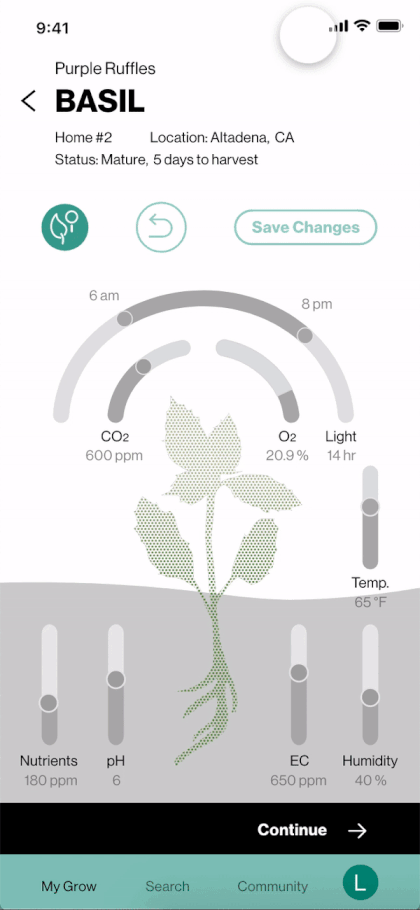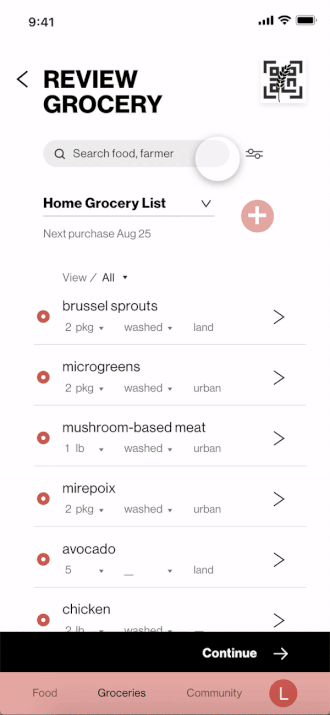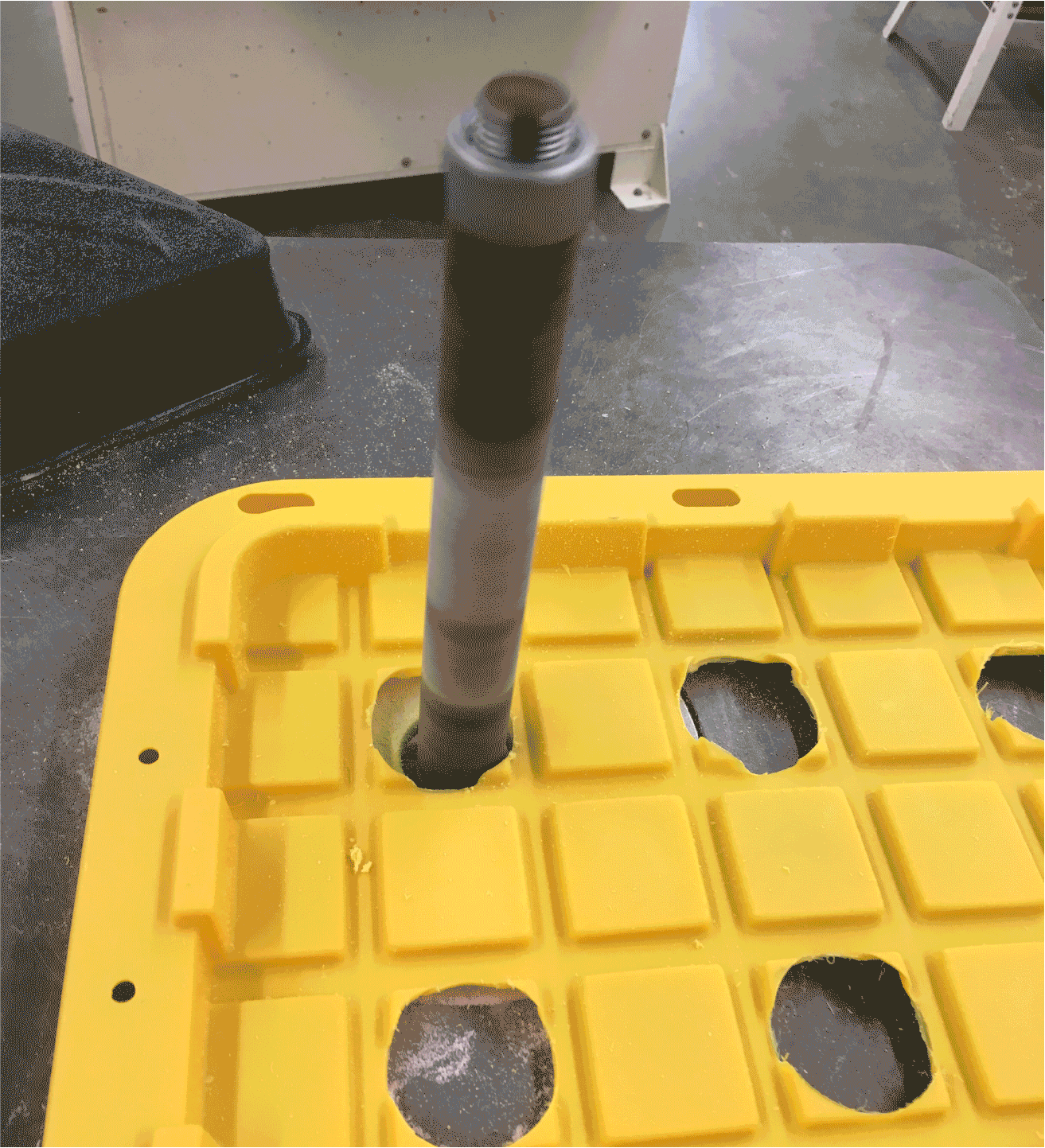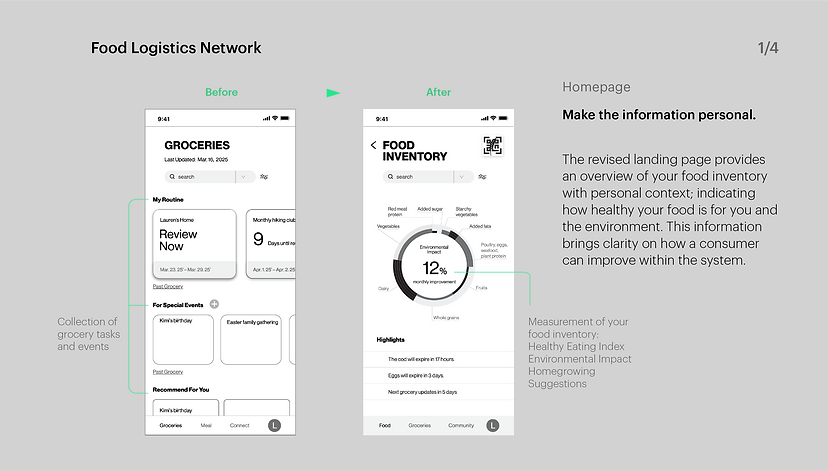-03.png)
The altAg Future
The altAg Future transforms the consumer's kitchen into an active part of the food system, empowering independent farmers and consumers to create a robust food chain
14 week individual project, 2019
User research, System design, UX + ID
As the environment struggles to withstand climate impact and modern farming, technologies such as genome engineering have come into play to shape the future of food and agriculture.
This project explores two possible futures of food: the current trajectory where industrialized practices dominate our food supply chain and industry innovations versus another alternative where the food system is composed of a network of independent organic farmers, with the support of open-source infrastructure in the digital age.
The project was initially inspired by the OpenAg Initiatives.
-44.png)
An IoT Kitchen Suite that engages consumers in food production and distribution.
Growing personalized crops
Grow crops that tailor to consumer’s nutritional/medical needs, based on one’s bio-data.


Connecting with local farmer network
Directly connect food demand with a network of independent local farmers who are certified with organic practices.


Tracing food source information
Build trust through providing access to food source information.
-28.png)
Design Challenge
"What is farm to table like in 2025?" – A Project to Reimagine our Future Food System
Observing the emerging technologies that are transforming the landscape of food and agriculture, I wanted to envision two potential futures:
1) If we continue on our current path, what will food be like in 2025?
2) If we are not satisfied with the future we are heading toward, what alternative solutions could we consider?
Research Process
-08.png)
To understand the current trajectory of our food system, I identified four critical factors: climate, biotechnology, farmers, and consumers. I then conducted field studies specific to the Central Valley in California. The Central Valley is one of the most agriculturally rich regions in the US and one of the most productive in the world.
-
Field studies: Independent organic farmers in the Central Valley
-
Expert interview: Climate scientist (JPL), neurobiologist (Caltech)
-
User interview (using generative tools): 5 consumers with different dietary needs
-
Secondary: Biotechnology, AgTech, climate impact in the Central Valley
Case Study: The Central Valley in California
Knowledge Goal: The current state of the food and agricultural system.
Field Studies
Knowledge Goal: The current state of modern farming. What are the pain points for farmers and environment?
User Research
Knowledge Goal: Understanding consumers' perceptions, needs and wants toward the current and future food system
-010.png)
Expert Interview
Knowledge Goal: How might climate variability and biotechnologies shape the future of food?

Research
The Food System
What we are going to eat in the future is at stake.
By 2050, as the world's population is expected to grow to 9.7 billion, food production will have to increase by 50% (UN). To meet this increasing food demand, we must build a food system that is robust to climate variability and minimizes harm to the environment.
Currently, there are three major roadblocks:
Climate Challenge
Climate impacts such as extreme weather events and warming temperatures have contributed to the loss of crop yields and the loss of arable land.
Industrialized Farming
Industrial farming took off in the 60's and has dramatically increased yield, using monoculture planting and synthesized fertilizers. However, this intensive method came at a price: a decline in food variety and nutritional value, and the degradation of land.
Food Logistics
To accommodate the global supply chain, food is engineered and processed to have a longer shelf life. For example, grapes may have traveled 2,100 miles to get to your plate. This entire distribution journey requires ‘cold chain’ storage and the carbon footprint of this is massive.
-04.png)
Emerging AgTechs
AgTechs are alleviating this challenge, but these innovations are poorly centralized.
Advanced technologies continue to transform the traditional food industry, ranging from biotechnology to AI and robotics. However, these innovations mainly belong to major biotech/infotech giants. This proprietary approach is limited as it makes the necessary transition slow and incompatible between companies.
Gene-editing:
Climate Resistant Seeds
PrecisionAg
Vertical Farming
Transparency + Connectivity: Sensing Technologies + Blockchain
key players: Benson Hill Biosystems, Corteva (division of DowDuPont), Yield10 Bioscience
Key technologies: Gene-editing: CRISPR
key players: Farmobile, JohnDeere, Cibo, Microsoft, AgEagle
Key technologies: Sensor technologies, IoT, Machine learning
Key players: Aerofarms, Gotham Green, infarm
Key technologies: Aeroponics/hydroponic, IoT, sensors
Key players: IBM Food Trust, WWF x BCG, Walmart
Key technologies: sensor technologies, blockchain
-05.png)
Photo: IBM
Photo: MIT Tech Review
Photo: Microsoft
Photo: Aerofarm
Future-proofing
_5-15.png)
How might a food system increase its availability, quality, and diversity of food while mitigating the environmental harm caused by agriculture?
Research Synthesis
Key Insights and Opportunities
The lack of time, distribution network, and technology make independent organic farming hard to sustain.
Consumers
Soaring distrust of food industries in the digital age
As mixed information become widespread in the digital age, consumer distrust to food industries grows.
“You simply can’t trust the food we’re getting now. You don’t know what kind of chemicals or processing methods they use.” –Jen W. (consumer, mom)
Independent Organic Farmers
The lack of time, technologies and distribution network
- Organic farming is labor-intensive. With limited time, capital, and conventional techniques, farmers struggle to produce and distribute crops efficiently to the market .
- As environmental challenges intensify, some farmers are giving up organic practices for industrialized solutions to increase yield.
→ create certified standard, provide fact check platform, enable transparency,
Isolated food chain fosters consumer ignorance
As the world are becoming increasingly urbanized, most consumers are left out in the process of food chain. The current environmental challenges of our food system are hard to grasp for many.
“Climate change is definitely real, but luckily I don’t think it’s impacting our lives yet.” – Alissa L.(consumer, vegetarian, waitress)
“We are pretty much at our climate threshold. This past year, we almost ran out of surface water and had to shut down agriculture.” – Josh F. (climate scientist, JPL)
“Farming is a full time job already. It’s difficult to find the market ourselves and sell these (avocado and citrus) to people.” – Alana K. (organic avocado farmer)
“It's getting harder to survive now. More and more farmers are starting to adopt industrialized methods. Sometimes I feel like we are the only one (practicing organic farming independently)…“ Alana K. (organic avocado farmer)
→ Assist digital adoption, create collaborate relationship to develop AgTechs, enhance connectivity through digital tools, open-source resources, form working group/ community
→ urban agriculture, engage consumers as part of the food system, personalized crops, education, develop farmer-consumer relationship
Healthy, affordable food products are poorly accessible
With predominant industrialized food chain in place, consumers find themselves lack of access to affordable, healthy food.
“(on purchasing organic food and changing diet) I want the kids to eat healthy too, but I’m busy, so a lot of time just whichever faster or closer I can get. It’s not like I have the time to go to farmer’s market.“ – Jen W. (consumer, mom)
→ enhance connectivity through digital tool, create opportunity to expand distribution
-07.png)
Affinity diagram to synthesize the research
Design Principles
Engaging consumers to be part of the food chain
Empowering independent organic farmers
Building trust
Leveraging AgTechs

Design Opportunities
The Open-Source Movement
Emerging organizations, such as FarmOS, are providing open-source access to farming innovations. Currently, these resources focus on specific purposes or communities; including STEM education, research, farmers, and hobbyists.
There is a great opportunity to use an open platform to transform the larger food system; from sharing farming resources to forming a food distribution network.

FarmOS, one of the emerging open-source resources for farmers
Photo: farmOS
The Potential of Open-Source and Urban Agriculture Haven't Been Fully Explored.
Urban Agriculture
Developing productive urban agriculture has the potential to achieve a certain degree of self-sufficiency and foster social development (Weidner et al.,2019). However, the currently urban agriculture methods have been hard to popularize because of its high-energy use and high-maintenance.
With the advances of renewable energy and digital infrastructure, there's a potential to expand urban agriculture and embedded in the urban food system.

Re-think the possibility of urban agriculture
Photo: phys.org
Development
Concept Development
Focusing on Consumer User Experience:
A New Food Network of Getting and Growing Food From Home.
Based on the research learning, I defined three critical criteria for achieving this preferable food system:
1) Engaging consumers to be part of the food system 2) Empowering independent organic farmers
3) Building trust through transparency
After three rounds of ideations, I decided to focus on the consumer’s experience at home, since it created a great potential to engage the masses and made this topic relevant to consumers.
-29.png)
-12.png)
Prototyping
Learning The Potential of Controlled-Environment Farming by Building an Indoor Growing Chamber
To understand the potential of indoor farming, I prototyped a controlled-environment (CE) growing chamber, using resources from the OpenAg forum. This process helped me understand how data could be collected to better inform both the consumer and agricultural system.
Four design criteria were determined:
1) Size modularity and scalability
2) Unobtrusively fits in the home environment
3) Ease of use for the consumer with little or no experience
4) Connects with a standardized open platform
-11.png)

Low-fi Sketches
Exploring options to communicate key user flows.
-13.png)
Mid-fi Iteration
I created a set of tap through prototypes and scenario boards to show this new experience of growing and getting food at home. The prototype was tested with both initial participants and new users. I received positive feedback for the overall concept.
Key iteration:
Task Flow
Before designing the hi-fi prototype, I cleaned up the flow of the whole experience, based on the learning from previous iterations.
User Flow
Design
The altAg Future
The altAg Future is an alternative proposal for our food system. Using an open-source platform, consumers can grow high-value, personalized crops, and source food directly from their local farmers, without relying on an industrialized food supply chain.
-27.png)
Key Strategies
01. A Collaborative Growing System: Open-Field Organic Farming +
AltAg Urban Farming
altAg Urban Farming in 2025
In 2025, as solar energy and composting energy becomes prevalent, altAg urban farming expands exponentially. Lots of obsolete indoor spaces, such as parking lots or retail stores, are converted into controlled-environment farms to grow climate-impacted, ancient, or high-value crops.
The collected crop data has been invaluable for the extensive agriculture system. Scientists have been using this dataset to develop new crop models and farming strategies. Flavorful and nutritious food is back on the dinner table.
-29.png)
Personalized altAg Indoor Farming at Home.
Using the altAg Grow tool, consumers can easily customize the growing system to fit in their kitchen. Some people use their bio-data to search or personalize seeds that tailor to their nutritional/medical needs, while some are just enjoying the novelty of growing exotic heirloom crops.
The components of this modular CE farming system are based on the learnings from OpenAgTM Personal Food Computer.
-24.png)


altAg Grow: Home indoor farming tool
02. Farmers as Brand:
A Real-Time and Local-Focused Food Distribution Network.
-28.png)


altAg Food: Food logistics service
In 2025, using IoT and sensing technologies, most kitchens are now connected to the altAg platform to manage food inventory. The platform allows a highly connected food network to form by monitoring crop availability and consumer needs. The food supply is distributed in real-time.
Any certified organic farmers, both open-field and CE farming, can easily register on the platform and join the supply source. As the altAg system learns from this ecosystem over time, the platform starts to give useful suggestions for the food chain, such as planting options and dietary management.
With the diversified supply network, this new food supply chain has become more robust and adaptive to climate variability.
-30.png)
-11.png)
altAg Food managing hub
.png)
03. Rebuild Trust:
Striking a Balance Among Transparency, Proprietary, and Privacy.
To ensure best practices, stakeholders from food supply to distribution channels are integrated with the altAg Platform to map out the flow of the food product and transfer the information from each step. Consumers use the altAg Food app to understand along their food's journey, such as the origin, nutritional value, and the environmental impact.
The altAg system provides a standardized platform to house and manage these agri-food datasets. The datasets are anonymized and used to optimize the agri-food chain.

_5-16.png)
_5-17.png)